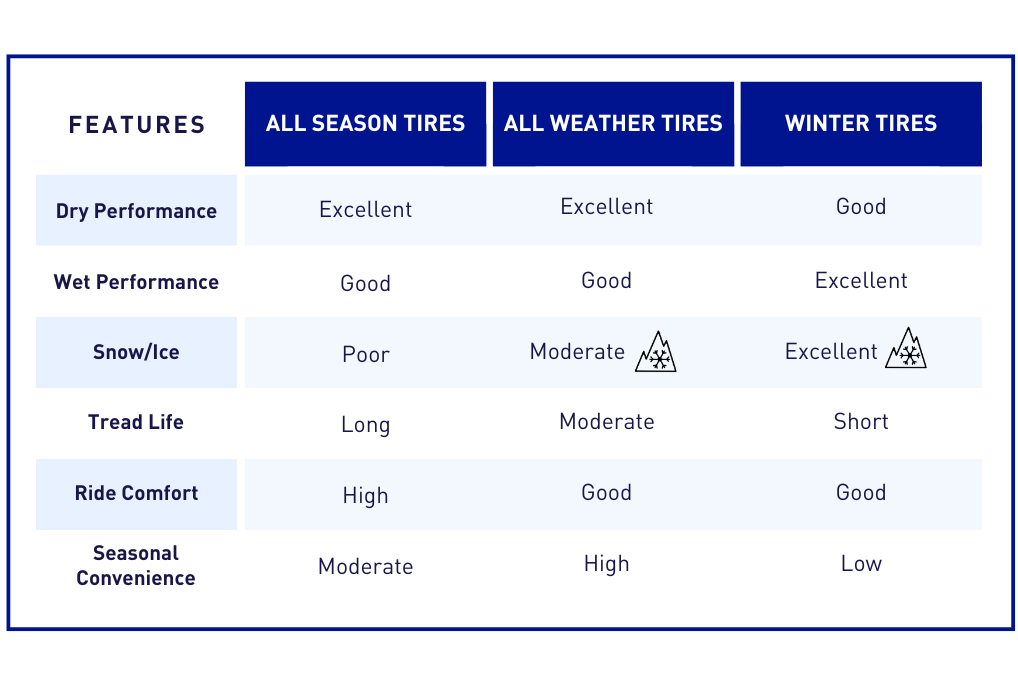WINTER TIRES
Can you see your breath?
If so, then it’s time to consider winter tires for your vehicle. When the temperature outside is 7 ℃ or below, your tires and your driving are affected. While not every Canadian region experiences lots of snow, the entire country has to endure winter temperatures. Winter tires are specifically designed to help keep you safe in colder weather conditions. This page is your Winter Tires 101 so you've got all the information you need to know when choosing snow tires for your vehicle.
What makes Winter Tires different?
- Cold Weather Performance: Rubber remains flexible in temperatures below 7°C (45°F).
- Enhanced Traction: Deep treads and biting edges improve grip on snow and ice.
- Safety: Shorter stopping distances and better handling in winter conditions.
the driving difference at 7 ℃

WINTER TIRE FAQS
Find out what’s legal, what the badges mean, and which winter tires are best for your vehicle.
All-season and all-weather tires harden in colder temperatures which lead to a reduction in traction. Winter tires work because their rubber composition is softer, which is why they stay flexible in the colder temperatures. They also have grooves that provide a better grip and handling in conditions like snow and ice. With winter tires, it’s about the temperature not the snow.
You should install your winter tires when you can see your breath, which is 7℃ and below. All-season and all-weather tires harden at this temperature which reduces their traction and handling. For more on all-season vs all-weather tires, click here.
For more information on seasonal tire changeover, click here.
Click here to book an appointment at your nearest Fountain Tire store.
![]() This is the 3-peaked mountain and snowflake (3PMS) symbol on the tire. It indicates the best winter tires for traction on snow and ice, and in cold weather.
This is the 3-peaked mountain and snowflake (3PMS) symbol on the tire. It indicates the best winter tires for traction on snow and ice, and in cold weather.
M+S: This is the mud and snow symbol on the side of the tire. These tires offer better performance in snow than summer or all-season tires.
1. Regularily inspect tire pressure (or PSI) and adjust to meet the pressure recommendation stated in your owner's manual or on the inside of the driver's door jam. With regular tire maintenance, you can lower your fuel costs and help protect the environment.
2. Annual wheel alignment service. Every time you run over a bump, hit a pothole, etc. your wheel alignment is thrown off, bit by bit. Once severe enough, your tires will be contacting the road surface at an off-angle, increasing rolling resistance, and ultimately causing your tires to wear excessively. This is why we recommend getting a wheel alignment service once a year or whenever the vehicle shows signs of tire damage or steering pull.
3. To make sure you're getting the most out of your winter tires, be sure to switch between summer or all-season tires and winter tires at the correct time. By using the handy 7℃ rule: always try to change your winter tires when the average temperature begins to rise above 7℃.
Yup! Winter tires have a single-directional tread that pushes away snow and ice. This includes grooves or sipes that provide a better grip and handling in conditions like snow and ice. They also have a deeper tread. Tires must have 3.5mm of tread remaining to be considered winter tires.
A lot of people don’t change their tires because of how expensive they are. However, according to Traffic Injury Research Foundation, ‘research suggests that using winter tires is, in the long-term, less expensive than using all-season tires.’ When you switch between two sets of tires, you prolong the life of each set. Find out which winter tires are best suited for your vehicle by filling out the form below.
Quebec and British Columbia are the only provinces that mandate winter tires in the winter months due to their mountain roads.
BRITISH COLUMBIA:
From October 1 to March 31 drivers must obey winter tire and chain signs throughout BC. It is recommended that drivers install mountain/snowflake tires for cold weather driving and, for extreme conditions, carry chains.
For more information please visit The Province of British Columbia.
QUEBEC:
In Quebec winter tires are mandatory by law from December 15 to March 15.
For more information please visit Société de l’assurance automobile Quebec.
If you’re replacing your tires, you should replace them all.
Having four tires with the same tread patterns, materials, size, and tread wear will improve handling. This will give you better control of your vehicle on wet, slippery roads.
Mixing tires can compromise your vehicle’s stability and can easily lead to oversteering and understeering, compromising road safety. That’s why Transport Canada recommends that snow tires be installed in sets of four. And why we’ve made it our policy at Fountain Tire.
For more information, view our Winter Tire Policy.
Featured Winter Tire

GOODYEAR WINTERCOMMAND ULTRA®
A prime example of Winter Season tires are GOODYEAR’s WINTERCOMMAND ULTRA® tires.
PRODUCT FEATURES:
- Tire is designed for use in severe snow conditions and meet specific snow performance test requirements with a Three-Peak Mountain Snowflake designation.
- Contains V-Tred™ Technology-featuring hydro-dynamic grooves to maximize water, slush and snow evacuation without compromising ride comfort.
- Experience phenomenal winter performance with a Cryo-Adaptive Compound engineered to improve pliability so you can own the road in extreme cold.
GET YOUR WINTER GROOVES
SOURCES
ICBC
Traffic Injury Research Foundation
{{showWheelsRims ? 'SEASONAL TIRE CHANGE' : 'NEW TIRE INSTALLATION'}}

Are your tires on wheels/rims? *
Required FieldWill you be storing your tires with us? *
Required FieldAre your tires already stored at the {{branch.branchName}} store? *
Required FieldAdditional Comment

SLOW LEAK AND/OR FLAT REPAIR

Which tire is losing air or flat?
 Front
Front




{{getSelectedTires()}}
Booking In Process

You currently have an appointment booking in process. If you make changes to your cart now your booking will be cancelled.
Booking Cart Cleared
As our products and servicess vary by store, we have cleared your booking cart. Please re-select the items for your appointment.
You need to select a store in order to obtain an accurate quote
Oops!
Something happened, please try again..No Locations Found
Please try your search again.
{{location.branchName}}
{{location.address}} {{location.city}}, {{location.province}}, {{location.postalCode}}
(Mobile Truck)
Thank you for requesting a quote.
{{branch.fullAddress}}
You need to select a store in order to obtain an accurate quote
Oops!
Something happened, please try again..No Locations Found
Please try your search again.
{{location.branchName}}
{{location.address}} {{location.city}}, {{location.province}}, {{location.postalCode}}
(Mobile Truck)
Thank you for requesting a quote.
{{branch.fullAddress}}
A set of tires is currently in your cart. Would you like to replace it?



A set of wheels is currently in your cart. Would you like to replace it?

Please Confirm Your Vehicle Details
Vehicle and Product Mismatch

The tires selected {{validationResult.tireSize}} do not match the manufacturer’s recommendation.
You can contact the store if you are unsure if the selected tire size is the right fit for your vehicle.
The wheels selected, {{validationResult.wheelSize}}, does not match per the vehicle manufacturer recommendation.
Putting on incorrect wheel size can be a real safety hazard or result in damaging the vehicle. It is recommended to put on wheels that matches the vehicle manufacturer.
You can contact the store, if you are unsure if the selected wheel size is the right fit for your vehicle.
The tires selected, {{validationResult.tireSize}}, and wheels selected, {{validationResult.wheelSize}}, do not match per the vehicle manufacturer recommendation.
Putting on incorrect tire/wheel size can be a real safety hazard or result in damaging the vehicle. It is recommended to put on tires/wheels that matches the vehicle manufacturer.
You can contact the store, if you are unsure if the selected wheel size is the right fit for your vehicle.




